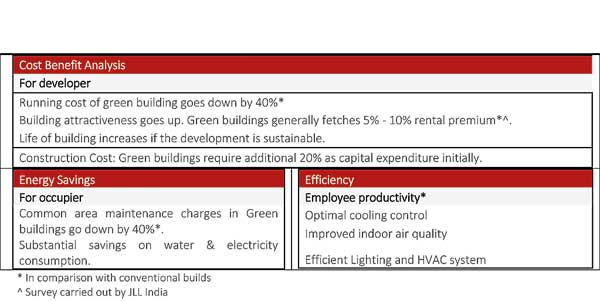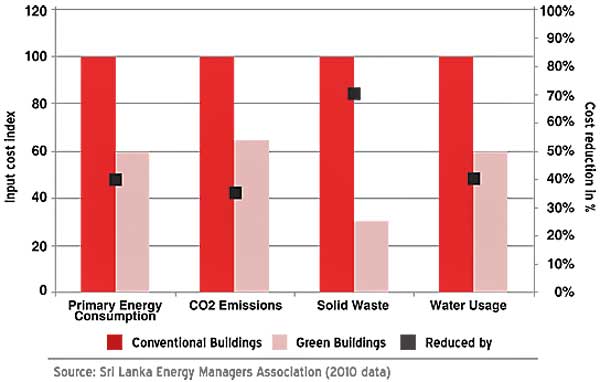 With the onset of political stability, Sri Lanka has actively pursued a policy of vigorous industrial and economic growth. Emerging now is an island that is being reshaped through utilisation of its natural bounty and undertaking of major construction activity to drive its economic engine of development. It would serve the country well, if during this initial phase itself, the concepts of sustainability and green architecture are made the underlying pillars for frenetic construction underway in the major cities.
With the onset of political stability, Sri Lanka has actively pursued a policy of vigorous industrial and economic growth. Emerging now is an island that is being reshaped through utilisation of its natural bounty and undertaking of major construction activity to drive its economic engine of development. It would serve the country well, if during this initial phase itself, the concepts of sustainability and green architecture are made the underlying pillars for frenetic construction underway in the major cities.
It is not as if ‘green’ is a novel concept for the island nation. The Sri Lanka chapter of Green Building Council has been in place since 2009 and already uses the LEED and ‘Green SL’ rating systems. Developers and industry participants are already enthusiastic to move towards green building practices. There are already instances of a few green projects in Sri Lanka and select projects are under construction.
-
The Brandix green factory situated in Seeduwa was the first in the apparel sector worldwide to receive a platinum rating from the Leadership in Energy and Environmental Design (LEED) rating system and the first in the world to obtain an ISO 50001 certification for its energy management.
The factory has become a benchmark and an international award winner for eco-friendly manufacturing and its commitment to environmental best practices.
-
Logistics Park is a state-of-the-art iconic green warehouse located on Avissawella Road, Orugodawatte and has approximately 100,000 square feet of space. The total investment in the warehouse is Rs.600 million.
-
Dynasty in Kandy is the city’s first-ever luxury apartment complex and is located just five minutes from the Kandy–Colombo Expressway. It is the first apartment project in Sri Lanka to be built under the LEED rating system.
-
Iceland Business Centre is a brand-new commercial building situated in Colombo 3, which is also LEED Certified and has a Platinum award. It has scored high on sustainability, water efficiency and energy consumption categories.
-
The Hirdaramani factory in Vavuniya has obtained LEED Gold Certification. This is the third LEED certified factory of the group. Their ongoing commitment to “green” is further strengthened whilst the existing facilities are converted to eco-friendly factories as well.
-
MAS Intimates - Thurulie, the ‘iconic’ eco-manufacturing facility of MAS Holdings, was awarded LEED (Platinum) certification by the U.S. Green Building Council and verified by the Green Building Certification Institute (GBCI). Built under the patronage of Marks & Spencer’s Plan A eco-initiative, MAS Intimates - Thurulie was the world’s first purpose-built green factory for apparel manufacturing.
The concerns regarding green buildings being ‘expensive’ compared to conventional buildings have been dispelled as the operational savings over the project lifecycle far outweigh the costs. Economies of scale for such projects enable the cost differential for ‘green buildings’ to also reduce gradually. While imbibing green architecture and energy efficient processes results in a better work environment and employee productivity, the conservation of nature also remains a key concern, which can be mitigated to an extent by using green techniques for the ‘built’ environment.
 Sri Lanka’s way forward
Sri Lanka’s way forward
As a developing country, construction activity across different asset classes and infrastructure development will be accompanied by some amount of environmental degradation and increased carbon emissions. Hence, the bottom-up approach of sustainable architecture has to be combined with the energy efficiency parameters to achieve truly green buildings.
A host of global corporate firms have committed to future real estate growth in green projects. An increased focus by commercial developers in this direction will definitely enable more corporate expansion within the country.
Sri Lanka has started on the right path by evolving a local rating system along with LEED. This will allow for a gradual learning and operationalization of green buildings on a bigger scale. As techniques and practices become more industry-intensive, Sri Lanka will be able to grow while maintaining a harmonious balance with its environment.

A regulatory framework, which can make certain elements of resource conservation and optimum utilisation mandatory for a certain scale of projects, will go a long way in creating a robust form of self-governance and new industry practices.
As the country takes baby steps towards energy-efficient green buildings, it can apply learnings of other countries and do it right in development of their real estate. If the right construction practices are adopted, green development rate could grow multi-fold in the coming years – boding well for Sri Lanka.
 With the onset of political stability, Sri Lanka has actively pursued a policy of vigorous industrial and economic growth. Emerging now is an island that is being reshaped through utilisation of its natural bounty and undertaking of major construction activity to drive its economic engine of development. It would serve the country well, if during this initial phase itself, the concepts of sustainability and green architecture are made the underlying pillars for frenetic construction underway in the major cities.
With the onset of political stability, Sri Lanka has actively pursued a policy of vigorous industrial and economic growth. Emerging now is an island that is being reshaped through utilisation of its natural bounty and undertaking of major construction activity to drive its economic engine of development. It would serve the country well, if during this initial phase itself, the concepts of sustainability and green architecture are made the underlying pillars for frenetic construction underway in the major cities. 
